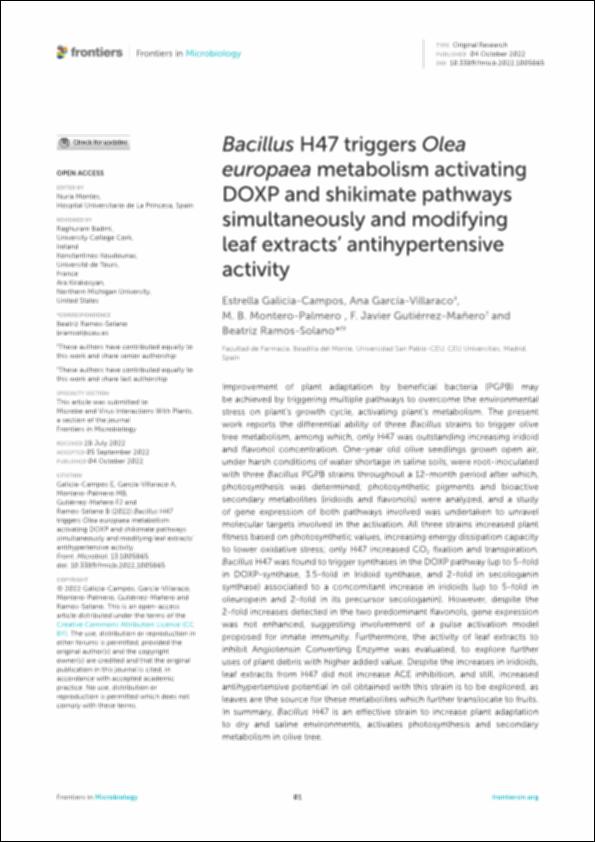Por favor, use este identificador para citar o enlazar este ítem:
http://hdl.handle.net/10637/14707Bacillus H47 triggers Olea europaea metabolism activating DOXP and shikimate pathways simultaneously and modifying leaf extracts’ antihypertensive activity
| Título : | Bacillus H47 triggers Olea europaea metabolism activating DOXP and shikimate pathways simultaneously and modifying leaf extracts’ antihypertensive activity |
| Autor : | Galicia Campos, Estrella García Villaraco, Ana Montero Palmero, María Belén Gutiérrez Mañero, Francisco Javier Ramos Solano, Beatriz |
| Materias: | PGPB; Secondary metabolism; Oleuropein; Flavonols; Olea europaea; Plant adaptation; Abiotic stress |
| Editorial : | Frontiers Media |
| Citación : | Galicia-Campos E, García-Villaraco A, Montero-Palmero MB, Gutiérrez-Mañero FJ and Ramos-Solano B (2022) Bacillus H47 triggers Olea europaea metabolism activating DOXP and shikimate pathways simultaneously and modifying leaf extracts’ antihypertensive activity. Front. Microbiol. 13:1005865. doi: 10.3389/fmicb.2022.1005865 |
| Resumen : | Improvement of plant adaptation by beneficial bacteria (PGPB) may be achieved by triggering multiple pathways to overcome the environmental stress on plant’s growth cycle, activating plant’s metabolism. The present work reports the differential ability of three Bacillus strains to trigger olive tree metabolism, among which, only H47 was outstanding increasing iridoid and flavonol concentration. One-year old olive seedlings grown open air, under harsh conditions of water shortage in saline soils, were root-inoculated with three Bacillus PGPB strains throughout a 12-month period after which, photosynthesis was determined; photosynthetic pigments and bioactive secondary metabolites (iridoids and flavonols) were analyzed, and a study of gene expression of both pathways involved was undertaken to unravel molecular targets involved in the activation. All three strains increased plant fitness based on photosynthetic values, increasing energy dissipation capacity to lower oxidative stress; only H47 increased CO2 fixation and transpiration. Bacillus H47 was found to trigger synthases in the DOXP pathway (up to 5-fold in DOXP-synthase, 3.5-fold in Iridoid synthase, and 2-fold in secologanin synthase) associated to a concomitant increase in iridoids (up to 5-fold in oleuropein and 2-fold in its precursor secologanin). However, despite the 2-fold increases detected in the two predominant flavonols, gene expression was not enhanced, suggesting involvement of a pulse activation model proposed for innate immunity. Furthermore, the activity of leaf extracts to inhibit Angiotensin Converting Enzyme was evaluated, to explore further uses of plant debris with higher added value. Despite the increases in iridoids, leaf extracts from H47 did not increase ACE inhibition, and still, increased antihypertensive potential in oil obtained with this strain is to be explored, as leaves are the source for these metabolites which further translocate to fruits. In summary, Bacillus H47 is an effective strain to increase plant adaptation to dry and saline environments, activates photosynthesis and secondary metabolism in olive tree. |
| URI : | http://hdl.handle.net/10637/14707 |
| Derechos: | http://creativecommons.org/licenses/by-nc-nd/4.0/deed.es OpenAccess |
| ISSN : | 1664-302X |
| Fecha de publicación : | 4-oct-2022 |
| Centro : | Universidad San Pablo-CEU |
| Aparece en las colecciones: | Facultad de Farmacia |
Los ítems de DSpace están protegidos por copyright, con todos los derechos reservados, a menos que se indique lo contrario.


